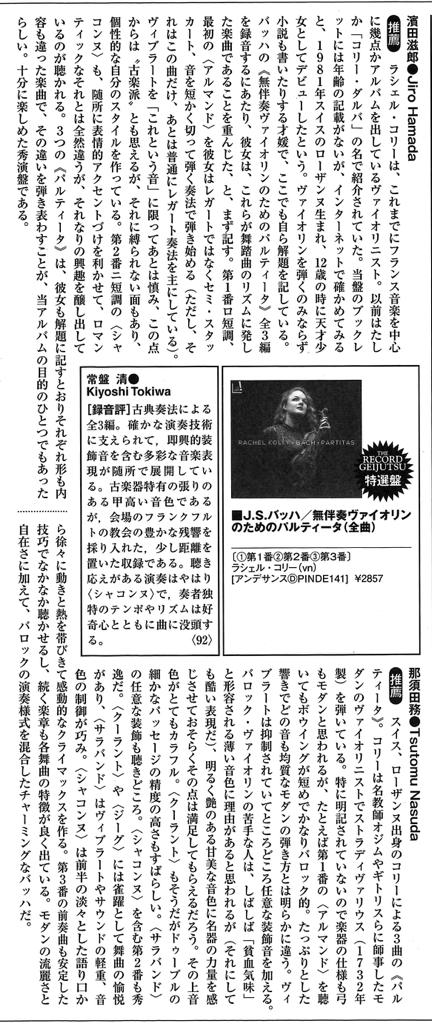01 NOV 2021 Record Geijutsu - Selection of the Month
3 Partitas by J.S. Bach
Recorded in Frankfurt for Indésens, on a 1732 Stradivari violin - English below
Jiro Hamada
Rachel Kolly is a violinist who has released several albums mainly on French music. I believe she was previously introduced under the name "Kolly D'Alba". Nothing is written about her age in the booklet of the album but according to internet search, she was born in Lausanne, Switzerland in 1981 and made her debut as a genius girl at the age of twelve. She is a talented woman who not only plays violin but also writes novels. The album note is written by herself. She writes in the beginning that, upon recording all three volumes of Bach's Partitas for Unaccompanied Violin, she respected the point that these are originated in the rhythm of dance music. No. 1 in B minor, she starts the first Allemande playing not legato, but semi-staccato, cutting notes short (this is however only for this song - the rest is played mainly with normal legato). She limits vibrato and uses it only to "this particular note", which reminds the style of "early music", but she is not tied to it in some aspects, creating her own unique style. No. 2 D minor Chaconne has expressive accents everywhere, which is completely different from the romantic one but is creating a certain taste. As she writes in the note, the three
Kiyoshi Tokiwa
All three volumes performed by classical playing method. Supported by reliable techniques, a variety of musical expressions including improvisational grace notes are scattered everywhere. Although it has a high-pitched tone which is peculiar to ancient instrument, it is recorded at a distance, incorporating the rich reverberation of the venue, church in Frankfurt. The performance especially worth listening is Chaconne as expected - the player’s unique tempo and rhythm induces curiosity and draws into the music.
Tsutomu Nasuda
Three Partita by Kolly from Lausanne, Switzerland. Kolly is a modern violinist who studied under the famous teachers Ozim and Gitlis, and plays Stradivarius (made in 1732). The specification of the instrument and the bow are though to be modern, but as recognized in No.1 Allemande, for example, the bowing is short and quite baroque. It is clearly different from the modern way of playing where every note sounds homogeneous with generous volume. Vibrato is limited and arbitrary grace notes are added in places. Some people dislike baroque violin because of the faint tone that is often described as "anemic" (terrible expression, indeed), but this performance should be satisfying for those people too, together with the power of the famous instrument which produces a bright, glossy and sweet tone. Besides, the tone is very colorful. As with Courante, the precision of the fine passage in Double is wonderful. Arbitrary decoration of Sarabande is one of the highlights. No. 2 including Chaconne is also excellent. Courante and Gigue contain the pleasure of dance music like a little bird jumping around, and Sarabande is skillfuly controled for vibrato, sound weight, and tone color. In Chaconne the plain tone in the first half gradually takes on movement and heat, creating a moving climax. The prelude of No. 3 attracts listeners again with the stable and skillful performance, and the following movements also express the characteristics of each dance music quite well. It is charming Bach that mixes baroque playing style with the elegance and freedom of modern style.